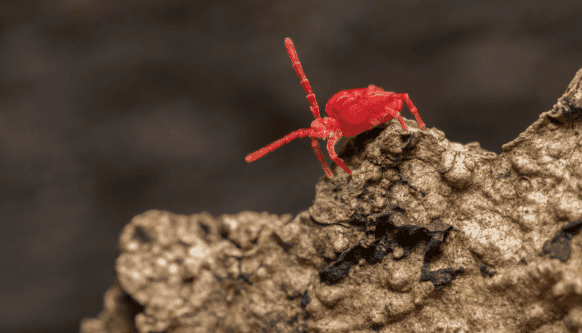Many small red bugs become active with the advent of spring and summer. Three of them – Clover mites, red spider mites, and tiny red ants are the most common of them.
These red pests make your garden beds their homes either for feeding on the plants or for nesting in the soil.
And they can also invade homes and harm indoor plants.
The worst part is that one of them can be dangerous. Because that red bug is infamous for painful bites and stings.
But if you take pre-emptive preventative pests, you won’t face the havoc that these pests cause.
Let’s find out what they’re, what they look like, and how to prevent bugs in your garden bed.
Clover Mites In Garden Bed

Clover mites are dark red bugs that feed on clover seeds. Their size is between 1/30 and 1/20 inches which makes them quite unnoticeable.
They’re oval-shaped with eight legs. Observing them under a magnifying glass can make you think that they’re spiders or ticks.
But they’re not despite coming from the family of arachnids. Spring and fall are the periods when they’re active.
They got their names because they feed on clover plants. But they feed on more than 100 plant species.
They feed on the plant’s sap, which makes the plants lose their vitality. Too many of them can cause serious harm to plants.
These mites can also enter homes through the cracks on the walls and windowsills.
But clover mites don’t bite humans. Neither do they cause any damage to your home.
However, they can trigger allergic reactions in people who are sensitive to bugs.
I panicked when I came across these red bugs on my bed.
You know why?
Because I thought of them as bed bugs. Anyone can confuse clover mites with bed bugs because of their shape, color, and size.
The best way to get rid of clover mites, and prevent them from coming back, is to regularly treat your garden with food grade diatomaceous earth.
White vinegar spray on the plants also eliminates these red mites.
Red Spider Mites

Spider mites come in different colors such as brown, white, yellow, green, and red. They’re smaller than clover mites, growing between 1/40 and 1/50 inches in size.
Their body shape makes them look like spiders. And they also weave silk webbings on the plants.
But, despite being arachnids, they don’t bite humans and they don’t feed on insects.
No matter what the color is, these sap-sucking mites are harmful plant pests.
They don’t just limit themselves to outdoor plants. They are a real threat to indoor plants as well, including greenhouse plants.
Red spider mites in garden bed are a clear sign that your plants have spider mites infestation.
Inspect your plants if you see red spider mites in your garden bed.
I guarantee you that you’ll notice signs like silk webbings and yellow and wilted leaves. These are the signs of spider mites damage.
Inspect the undersides of the leaves and the branch junctions. You’ll find spider mites and their larvae hiding in these places.
Spider mites, like clover mites, can also sneak inside homes. You can also accidentally bring them to your home by introducing plants with spider mites indoors.
Soapy water spray, white vinegar spray, and diatomaceous earth eliminate spider mites from plants.
You might need insecticidal soap if there are too many of them.
Red Ants

There are many species of red ants that can make their nests in garden beds and yard soil.
Some of them are pharaoh ants and weaver ants.
However, on soil beds, it’s the red fire ants that you must be very careful of.
These ants are dark red, and they can make their nests in garden bed soil and grass lawns.
Red fire ants, and all the other red ants in garden bed and yard soil, will surely invade homes.
Red fire ants inside the house can damage electricals and appliances.
My honest advice would be to keep away from these red ants. Hire a professional pest controller to get rid of them.
And do not try DIY methods to eliminate these ants. You’ll expose yourself to the risks their venomous stings.


